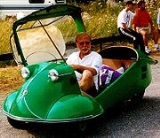
Fritz Fend
Encyclopedia
Fritz Fend: was an aeronautical engineer. He worked for Messerschmitt
and designed the famous Kabinenroller (cabinscooter) KR175 / KR200.
Fend was a technical officer with the Luftwaffe
during World War II
.
, Germany
. In 1948, he devised an invalid carriage in the form of a tricycle
. The front wheel of the tricycle was powered by pushing the handlebars back and forth. Originally designed with bicycle wheels, it was redesigned with scooter wheels in order to make the carriage lower. Fend later made a version that was powered by a 38 cc Victoria
two-stroke engine.
moped
with a cargo platform or trunk between the front wheels.
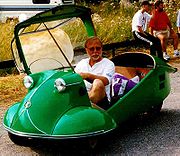
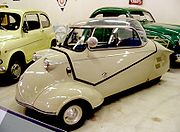 Many Flitzer buyers were not invalids but healthy people seeking basic personal transportation. This led Fend to design the Fend 150, a larger, two-passenger car based on the concepts of the Flitzer. With mass production in mind, Fend approached Willy Messerschmitt
Many Flitzer buyers were not invalids but healthy people seeking basic personal transportation. This led Fend to design the Fend 150, a larger, two-passenger car based on the concepts of the Flitzer. With mass production in mind, Fend approached Willy Messerschmitt
with a proposal for Messerschmitt AG
to build a more developed version of the Fend 150.
Messerschmitt, needing products to build to keep his factories working, accepted the Fend 150, which was still being developed, and the Lastenroller, which was put into production.
KR200 production expanded to three models in 1957 with the introduction of the "Kabrio" convertible and the KR201 Roadster.
Production of the KR200 was heavily reduced in 1962 and ceased in 1964
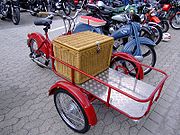 In 1956, Messerschmitt was allowed to manufacture aircraft again and lost interest in Fend's microcars. Messerschmitt sold the Regenburg works to Fend, who, with brake and hub supplier Valentin Knott, formed Fahrzeug- und Maschinenbau GmbH, Regensburg (FMR) to continue production of the KR200 and his other vehicles. FMR was allowed to continue using the Messerschmitt name and logo on the KR200. The Fend Lastenroller was developed into the FMR Mokuli, versions of which were manufactured by FMR until 1972.
In 1956, Messerschmitt was allowed to manufacture aircraft again and lost interest in Fend's microcars. Messerschmitt sold the Regenburg works to Fend, who, with brake and hub supplier Valentin Knott, formed Fahrzeug- und Maschinenbau GmbH, Regensburg (FMR) to continue production of the KR200 and his other vehicles. FMR was allowed to continue using the Messerschmitt name and logo on the KR200. The Fend Lastenroller was developed into the FMR Mokuli, versions of which were manufactured by FMR until 1972.
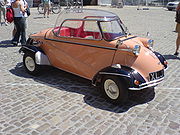 Fend developed the four-wheeled, twin-cylinder FMR Tg500 from the platform that had begun with the KR175. The front suspension, monocoque, and bodywork ahead of the rear sub-frame was derived from the KR200, but the rear sub-frame bore a suspension and drivetrain with twice the number of wheels and an engine with twice the number of cylinders and more than twice the displacement. The Tg500 was aimed primarily at sporting enthusiasts and was built from 1958 to 1961. About 320 were made.
Fend developed the four-wheeled, twin-cylinder FMR Tg500 from the platform that had begun with the KR175. The front suspension, monocoque, and bodywork ahead of the rear sub-frame was derived from the KR200, but the rear sub-frame bore a suspension and drivetrain with twice the number of wheels and an engine with twice the number of cylinders and more than twice the displacement. The Tg500 was aimed primarily at sporting enthusiasts and was built from 1958 to 1961. About 320 were made.
. A 4-wheeler prototype vehicle was built, but Fend's sudden death in 2000 ended this project.
Messerschmitt
Messerschmitt AG was a famous German aircraft manufacturing corporation named for its chief designer, Willy Messerschmitt, and known primarily for its World War II fighter aircraft, notably the Bf 109 and Me 262...
and designed the famous Kabinenroller (cabinscooter) KR175 / KR200.
Fend was a technical officer with the Luftwaffe
Luftwaffe
Luftwaffe is a generic German term for an air force. It is also the official name for two of the four historic German air forces, the Wehrmacht air arm founded in 1935 and disbanded in 1946; and the current Bundeswehr air arm founded in 1956....
during World War II
World War II
World War II, or the Second World War , was a global conflict lasting from 1939 to 1945, involving most of the world's nations—including all of the great powers—eventually forming two opposing military alliances: the Allies and the Axis...
.
The Rosenheim works
After the war, Fend had a workshop in RosenheimRosenheim
Rosenheim is a town in Bavaria at the confluence of the rivers Inn and Mangfall. It is seat of administration of the district of Rosenheim, but is not a part of it.-Geography:...
, Germany
Germany
Germany , officially the Federal Republic of Germany , is a federal parliamentary republic in Europe. The country consists of 16 states while the capital and largest city is Berlin. Germany covers an area of 357,021 km2 and has a largely temperate seasonal climate...
. In 1948, he devised an invalid carriage in the form of a tricycle
Tricycle
A tricycle is a three-wheeled vehicle. While tricycles are often associated with the small three-wheeled vehicles used by pre-school-age children, they are also used by adults for a variety of purposes. In the United States and Canada, adult-sized tricycles are used primarily by older persons for...
. The front wheel of the tricycle was powered by pushing the handlebars back and forth. Originally designed with bicycle wheels, it was redesigned with scooter wheels in order to make the carriage lower. Fend later made a version that was powered by a 38 cc Victoria
Victoria (motorcycle)
Victoria was a bicycle manufacturer in Nürnberg, Germany that made motorcycles from about 1901 until 1966. It should not be confused with a lesser-known, unrelated Victoria Motorcycle Company in Glasgow, Scotland that made motorcycles between 1902 and 1928....
two-stroke engine.
Fend Flitzer
Fend then designed and built the Fend Flitzer, an invalid carriage designed from the start to be powered by an engine. He reversed the layout of his original tricycle, giving the Flitzer two front wheels and one rear wheel. As with usual convention, the front wheels were steered while the rear wheel was powered. About 250 Flitzers were built between 1948 and the end of production in 1951.Utility vehicles
In addition to the invalid carriages, Fend designed and built the Fend Lastenroller, a three-wheeled forecarForecar
A Forecar was a car body style adopted by several makers of light cars and motorcycles in the first decade of the 20th century.In this type of body, the passenger seat was placed in front of the engine. It was usually placed above the front axle, leaving the occupant extremely vulnerable in the...
moped
Moped
Mopeds are a type of low-powered motorcycle designed to provide economical and relatively safe transport with minimal licensing requirements.Mopeds were once all equipped with bicycle-like pedals , but moped has been increasingly applied by governments to vehicles without pedals, based on their...
with a cargo platform or trunk between the front wheels.
Messerschmitt


Willy Messerschmitt
Wilhelm Emil "Willy" Messerschmitt was a German aircraft designer and manufacturer. He was born in Frankfurt am Main, the son of a wine merchant...
with a proposal for Messerschmitt AG
Messerschmitt
Messerschmitt AG was a famous German aircraft manufacturing corporation named for its chief designer, Willy Messerschmitt, and known primarily for its World War II fighter aircraft, notably the Bf 109 and Me 262...
to build a more developed version of the Fend 150.
Messerschmitt, needing products to build to keep his factories working, accepted the Fend 150, which was still being developed, and the Lastenroller, which was put into production.
KR175
The development of the Fend 150 led to the production of the Messerschmitt KR175, which began in February 1953. Development continued after production began, resulting in 70 modifications of the design by June 1953. However, the KR175's excellent road manners and relative lack of width made it a good city commuter.KR200
In 1955, Messerschmitt replaced the KR175 with the KR200. Apart from a larger engine, the KR200 had improved suspension (introducing shock absorbers to the design), improved engine mounting, larger tires, improved controls, and a means by which to reverse the car. Reverse was accomplished not by including a reverse gear in the transmission but by reversing the rotation of the engine itself.KR200 production expanded to three models in 1957 with the introduction of the "Kabrio" convertible and the KR201 Roadster.
Production of the KR200 was heavily reduced in 1962 and ceased in 1964
FMR

Tg500

After FMR
Fritz Fend left FMR after they stopped building the KR200. Fend continued his career as a technical designer and an inventor. He invented an alarm that went on if the key was removed from a car ignition while the lights were still on, a feature that became popular after his patent ran out.Fend's last project
In the 1990s, Fend began working on the F2000, a modern low-weight low-drag vehicle reminiscent of the KabinenrollerMesserschmitt KR200
The Messerschmitt KR200, or Kabinenroller , was a three-wheeled bubble car designed by the aircraft engineer Fritz Fend and produced in the factory of the German aircraft manufacturer Messerschmitt from 1955 to 1964.-History:...
. A 4-wheeler prototype vehicle was built, but Fend's sudden death in 2000 ended this project.
External links
- PyttiPanna Moped Museum - Obituary notice
- Achim Lüdecke - Hobby und Beruf (in German)

